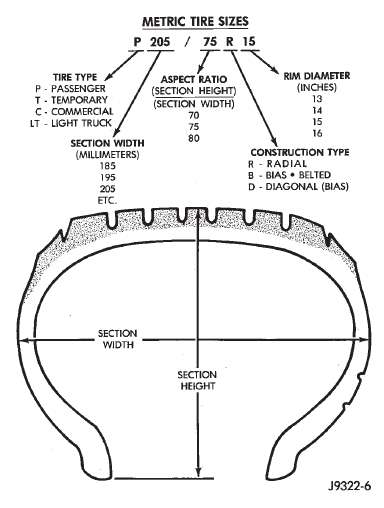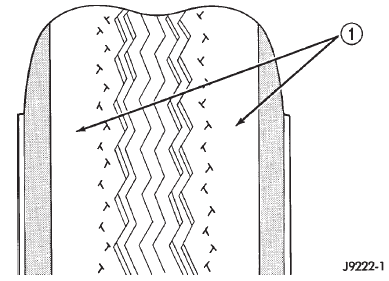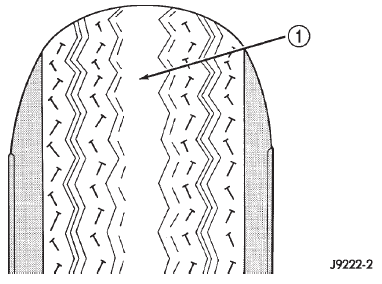Description and operation
DESCRIPTION Tires are designed and engineered for each specific
vehicle. They provide the best overall performance
for normal operation. The ride and handling characteristics
match the vehicle's requirements. With
proper care they will give excellent reliability, traction,
skid resistance, and tread life.
Driving habits have more effect on tire life than
any other factor. Careful drivers will obtain in most
cases, much greater mileage than severe use or careless
drivers. A few of the driving habits which will
shorten the life of any tire are: Radial-ply tires are more prone to irregular tread
wear. It is important to follow the tire rotation interval
shown in the section on Tire Rotation. This will
help to achieve a greater tread life. TIRE IDENTIFICATION Tire type, size, aspect ratio and speed rating are
encoded in the letters and numbers imprinted on the
side wall of the tire. Refer to the chart to decipher
the tire identification code (Fig. 1).
Performance tires have a speed rating letter after
the aspect ratio number. The speed rating is not
always printed on the tire sidewall. These ratings
are: An All Season type tire will have either M + S, M
& S or M-S (indicating mud and snow traction)
imprinted on the side wall. TIRE CHAINS Tire snow chains may be used on certain models.
Refer to the Owner's Manual for more information.
DESCRIPTION Radial-ply tires improve handling, tread life and
ride quality, and decrease rolling resistance.
Radial-ply tires must always be used in sets of
four. Under no circumstances should they be used on
the front only. They may be mixed with temporary
spare tires when necessary. A maximum speed of 50
MPH is recommended while a temporary spare is in
use.
Radial-ply tires have the same load-carrying capacity
as other types of tires of the same size. They also
use the same recommended inflation pressures.
The use of oversized tires, either in the front or
rear of the vehicle, can cause vehicle drive train failure.
This could also cause inaccurate wheel speed
signals when the vehicle is equipped with Anti-Lock
Brakes.
The use of tires from different manufactures on the
same vehicle is NOT recommended. The proper tire
pressure should be maintained on all four tires. Spare tire-temporary DESCRIPTION The temporary spare tire is designed for emergency
use only. The original tire should be repaired
or replaced at the first opportunity, then reinstalled.
Do not exceed speeds of 50 M. P. H. when using the
temporary spare tire. Refer to Owner's Manual for
complete details. DESCRIPTION Under inflation will cause rapid shoulder wear, tire
flexing, and possible tire failure (Fig. 2).
1 - THIN TIRE THREAD AREAS Over inflation will cause rapid center wear and
loss of the tire's ability to cushion shocks (Fig. 3).
1 - THIN TIRE THREAD AREA Improper inflation can cause: For proper tire pressure specification refer to the
Tire Inflation Pressure Chart provided with the vehicles
Owners Manual. A Certification Label on the
drivers side door pillar provides the minimum tire
and rim size for the vehicle. The label also list the
cold inflation pressure for these tires at full load
operation
Tire pressures have been chosen to provide safe
operation, vehicle stability, and a smooth ride. Tire
pressure should be checked cold once a month. Tire
pressure decreases as the ambient temperature
drops. Check tire pressure frequently when ambient
temperature varies widely.
Tire inflation pressures are cold inflation pressure.
The vehicle must sit for at least 3 hours to obtain the
correct cold inflation pressure reading. Or be driven
less than one mile after sitting for 3 hours. Tire
inflation pressures may increase from 2 to 6 pounds
per square inch (psi) during operation. Do not reduce
this normal pressure build-up. WARNING: OVER OR UNDER INFLATED TIRES
CAN AFFECT VEHICLE HANDLING AND TREAD
WEAR. THIS MAY CAUSE THE TIRE TO FAIL SUDDENLY,
RESULTING IN LOSS OF VEHICLE CONTROL. DESCRIPTION Where speed limits allow the vehicle to be driven
at high speeds, correct tire inflation pressure is very
important. For speeds up to and including 120 km/h
(75 mph), tires must be inflated to the pressures
shown on the tire placard. For continuous speeds in
excess of 120 km/h (75 mph), tires must be inflated
to the maximum pressure specified on the tire sidewall.
Vehicles loaded to the maximum capacity should
not be driven at continuous speeds above 75 mph
(120 km/h).
For emergency vehicles that are driven at speeds
over 90 mph (144 km/h), special high speed tires
must be used. Consult tire manufacturer for correct
inflation pressure recommendations. DESCRIPTION The original equipment tires provide a proper balance
of many characteristics such as: It is recommended that tires equivalent to the original
equipment tires be used when replacement is
needed.
Failure to use equivalent replacement tires may
adversely affect the safety and handling of the vehicle.
The use of oversize tires may cause interference
with vehicle components. Under extremes of suspension
and steering travel, interference with vehicle
components may cause tire damage. WARNING: FAILURE TO EQUIP THE VEHICLE WITH
TIRES HAVING ADEQUATE SPEED CAPABILITY
CAN RESULT IN SUDDEN TIRE FAILURE.Tires
 Fig. 1 Tire Identification
Fig. 1 Tire IdentificationRadial-ply tires
Tire inflation pressures
 Fig. 2 Under Inflation Wear
Fig. 2 Under Inflation Wear Fig. 3 Over Inflation Wear
Fig. 3 Over Inflation Wear
Tire pressure for high speed
Replacement tires
Dodge Durango (DN) 1998-2003 Service Manual
- Lubrication and Maintenance
- Suspension
- Differential and Driveline
- Brakes
- Cooling System
- Battery
- Starting Systems
- Charging System
- Ignition System
- Instrument Panel Systems
- Audio Systems
- Horn Systems
- Speed Control System
- Turn Signal and Hazard Warning Systems
- Wiper and Washer Systems
- Lamps
- Passive Restraint Systems
- Electrically Heated Systems
- Power Distribution System
- Power Lock Systems
- Vehicle Theft/Security Systems
- Power Seat System
- Power Window Systems
- Power Mirror Systems
- Chime/Buzzer Warning Systems
- Overhead Console Systems
- Engine
- Exhaust System
- Frame and Bumpers
- Fuel System
- Steering
- Transmission and Transfer Case
- Tires and Wheels
- Body
- Heating and Air Conditioning
- Emission Control Systems
- Introduction
